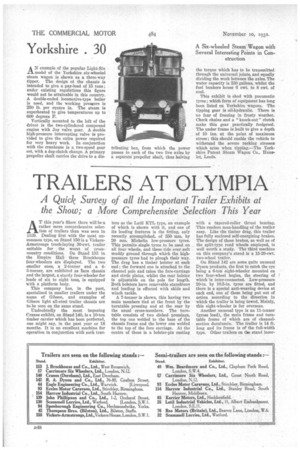Yorkshire . 30
Page 38

If you've noticed an error in this article please click here to report it so we can fix it.
AN example of the popular Light-Six model of the Yorkshire six-wheeled steam wagon is shown as a three-way tipper. The design of the chassis is intended to give a pay-load of 15 tons; under existing regulations this figure would not be attainable in this country. A double-ended locomotive-type boiler is used, and the working presgure is 250 lb. per square in. The steam is superheated to give temperatures up to 600 degrees F. Vertically mounted to the left of the driver is the two-cylindered compound engine with Joy valve gear. A double high-pressure intercepting valve is provided to give the extra power required for very heavy work. In conjunction with the crankcase is a two-speed gear set, with a dog-clutch change. A primary propeller shaft carries the drive to a us the torque which has to be transmitted through the universal joints, and equally dividing the work between the axles. The water capacity is 230 gallons, whilst the fuel bunkers house 6 cwt. to 8 cwt. of coal.
This exhibit is shod with pneumatic tyres; which form of equipment has long been listed on Yorkshire wagons. The tipping gear is oil-hydraulic. There is no fear of freezing in frosty weather. Check chains and a " knock-out" clutch make this gear practically foolproof. The under frame is built to give a depth of 10 ins. at the point of maximum stress ; this should enable the vehicle to withstand the severe racking stresses which arise when tipping.--The Yorkshire Patent Steam Wagon Co., Hunslet, Leeds.
















































































































































